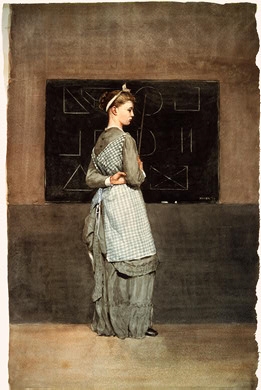To mark the end of the summer holidays and the start of a new school year, this week’s picture, on an appropriately pedagogical theme, is Winston Homer’s Blackboard. An impressively austere depiction of an upright schoolmistress going about her work, while keeping a sideways eye on her charges, is to be found in the collections of the National Gallery of Art in Washington.
Homer was in his early forties when he painted Blackboard, which may have been inspired in part by his own memories of going to school in Cambridge, Massachusetts, in the 1840s and early 1850s. By all accounts he had been a somewhat indifferent pupil, who spent more time drawing in the margins of his textbooks than he did reading them. From an early age it seems that he had chosen to aim for artistic rather than academic excellence, a decision borne out by his rise to fame, and a modest fortune, as one of the leading American painters of his time. Homer had left formal education and the schoolhouse behind at the age of eighteen to take up a position as apprentice in a busy lithographic workshop in Boston. Moving to New York, he found work as an artist-correspondent for Harper’s Weekly, one of the leading popular journals of the day. The American Civil War was at its height and Homer depicted its bloody battles and their dismal aftermaths with tireless energy, rapidly establishing himself as one of the principal chroniclers of his own nation’s most calamitous conflict. At a relatively early age he found that he had become a household name.
Blackboard, however, was painted during the next phase of Homer’s career, when after having visited Europe and studied the works of the Old Masters at first hand, he had given up...


